I was stuck.
I knew I needed a decent website, but I had no idea what to do or where to start.
Five free websites later, I had a lot of questions.
-
- Do I need my own domain name?
- How do I choose a good one?
- How do I build my own site?
- How can I make it look great with no coding skills?
- What content do I need on my site?
It turns out, setting up a website can be hard.
And yet, a freelancer’s website is crucial to their success.
Freelance web designer Leah Kalamakis says:
“Your website is your #1 sales tool. It’s the first impression you give to potential clients and it’s the space where you have the most opportunity to show people what you can do for them and convert them into paying clients.”
Without a decent website, you’ll find it hard to create your ultimate freedom freelancer lifestyle.
Thankfully, I’ve got you covered. I’ve made all of the mistakes so you don’t have to.
In Part 1, I’m going to show you how to setup your professional freelance website.
And in Part 2, we’ll going to develop your visual brand and create the content that will land you the clients you deserve.
But first, let me clear one thing up.
Professional Freelancers Shouldn’t Use Free Website Builders
It’s easy to understand the allure of free website builders like Wix or Weebly.
They’re easy to set up and will save you a few bucks.
But if you’re serious about growing your freelance business, there are some significant disadvantages to these services.
First, your domain name will be something like: www.yourname.wordpress.com or www.yourname.weebly.com.
A subdomain from a free site like this tells your client one of 4 things:
- You don’t take your business seriously enough to invest in it.
- You’re not making enough money to invest in your business.
- You’re a hobbyist, not a serious professional.
- You’re behind the times and don’t realize the importance of having a website today.
None of these are good.
Also, free website builders tend to have limited features.
Why?
Because when you’ve spent two days tweaking your color scheme and realize you need a mailing list opt-in form, you’ll have to upgrade to a premium plan to get it.
What’s more, you don’t control your content.
If you use a third-party host, they’ll own your website and all the information on it.
This is worrying.
Especially when they can take your website down whenever they like without warning — even for just using a non-Facebook standard icon!
Finally, there’s the opportunity cost.
With a third-party site like this, you won’t be able to scale or customize your website as your career progresses.
Entrepreneur Brian Edmondson writes, “If you’re looking to build a serious business online, you must host your own blog to maintain full ownership and control of it.”
So, let’s do just that and get you set up with a professional freelance website.
1. Pick Your Domain Name
Picking a domain name can be difficult. Why?
Because your entire business and life from now on will depend solely on this one decision!
Just kidding.
But if you’re anything like me, you might feel like that.
Try not to stress over picking a domain name. It’s not going to be perfect — nothing ever is.
Your Name or a Business Name?
When picking your domain name you have three options:
- Using a variation of your own name, i.e. johnsmithgraphicdesigner.com
- Using your own name (if you’re lucky), i.e. johnsmith.com
- Using a unique business name
There are pros and cons to each, but try to avoid option 1.
Why?
Including your profession in your name (i.e. writer, graphic designer, etc.) limits you.
A domain name like johnsmithgraphicdesigner.com only showcases your hard skills — in this case, graphic design.
But the most successful freelancers also leverage their internal skills, people skills and life experience.
You can learn more about this by downloading “The Anti-Commodity Formula” workbook.
Preston Lee, freelance graphic designer and founder of Millo, says:
“Unfortunately, some people associate the small feel using your name can create with inability to perform … A business name makes you sound more experienced and more dedicated to the design work you do. Because of that, it’s possible clients are willing to pay higher rates than if you give off a one-man show aura.”
Also, if John Smith wants to add web development or SEO to his freelancing services, his domain name will no longer represent his business.
Then there’s option 2: yourname.com.
If you’re lucky enough to be able to get yourname.com, check if you can also get the relevant social media profiles.
You’ll also want to check if you can rank higher on Google than other people with the same name.
(If your name is John Smith, you’ve got no chance.)
Still, there are two main drawbacks to using your own name.
First, if you decide to grow your business and take on staff in the future, you’ll likely want a new name.
Wes McDowell, creative director at The Deep End Design, says:
“I knew I didn’t want to be a one-man-band forever, so I ditched ‘Wes McDowell Creative’ in favor of the more growth-friendly ‘The Deep End Design.’”
And second, it’s a lot easier to separate your personal life from your professional life online when you’re using a unique business name.
You don’t want potential clients stumbling over your old vacation photos.
If you decide to create a business name, try to make it intuitive. You want your domain name to give people an idea of what you do.
The aim of the game is balance.
For example, I chose killitcopy.com, as I knew that the center of my work was going to be in writing and marketing.
But note how I didn’t use narrow, restricting words like “blogger” or “journalist.”
“Copy” is an umbrella term for a few types of writing. So, although most of my work is writing blog posts, I can always expand into other forms of writing.
Ultimately, try to pick something flexible. As time goes on, you and your business will grow and change.
Follow These Domain Guidelines
Keep It Simple and Short
Difficult is bad, simple is good.
Why? Because of something called “cognitive fluency.”
As the Boston Globe explains, “Cognitive fluency is simply a measure of how easy it is to think about something, and it turns out that people prefer things that are easy to think about to those that are hard.”
For example, we prefer Walmart.com over Wmansitx.com, because it’s easier to read and remember
Get a .com
Although there are tons of other TLD (top level domain) extensions out there, “.com” is still the most recognized and accessible.
Make Sure It’s Brandable
Ask yourself, does this sound like a brand?
To adopt an example from Moz, if you wanted to get into marketing:
- Spreadtheword-marketing.com would be hard to brand or remember.
- Dexterousmarketing.com is unique and brandable, but long and difficult to say.
- MarketingLabs.com is unique, memorable, and would be easy to brand with the scientific connotation.
Avoid Trademark Infringement
Don’t pick a domain name that is the name of another company or business.
Not only can it create brand confusion, you could get sued.
Rand Fishkin, co-founder of Moz, says:
“You have to be careful because it’s not whether you think your domain name could be confused. It’s whether you think a judge in a jurisdiction, where a company might take legal action against you, would consider your domain name confusable.
Trademark owners can attempt to sue a domain name owner, who’s owning the domain legitimately and using it for business purposes, and that sucks.”
A quick Google search should be able to tell you whether to avoid a name or not.
However, talk to an attorney or a legal professional if you have real concerns.
Discover Your Domain Name
Let’s run through the exact steps you need to take:
- Open up GoDaddy.
- Input a ton of potential domain names to see if they’re available.
- Create a list of available potential domain names.
- Check these names on the big social networks like Twitter and Facebook.
- Narrow the list down to your favorites.
- Ask friends and family for their opinion.
- Wait for the dust to settle. (What seems like a good idea now might not be in retrospect!)
- Pick one!
It might not feel perfect, but if it ticks all the boxes, go for it.
You’ll grow into it too.
“The Beatles” is a terrible band name. It’s not even spelled right. But it works, because of what the name came to represent — insane talent and ground-breaking songwriting.
Have fun!
2. Get Your Hosting
Now that the hard part is over, let’s get you set up with your website.
Bluehost has been a recommended host by WordPress since 2005 and are currently hosting more than 850,000 WordPress websites.
And your domain name and hosting on Bluehost will only cost you $3.95/month.

Once you’ve clicked on the basic package, follow the instructions to select your domain name, and then input your information.
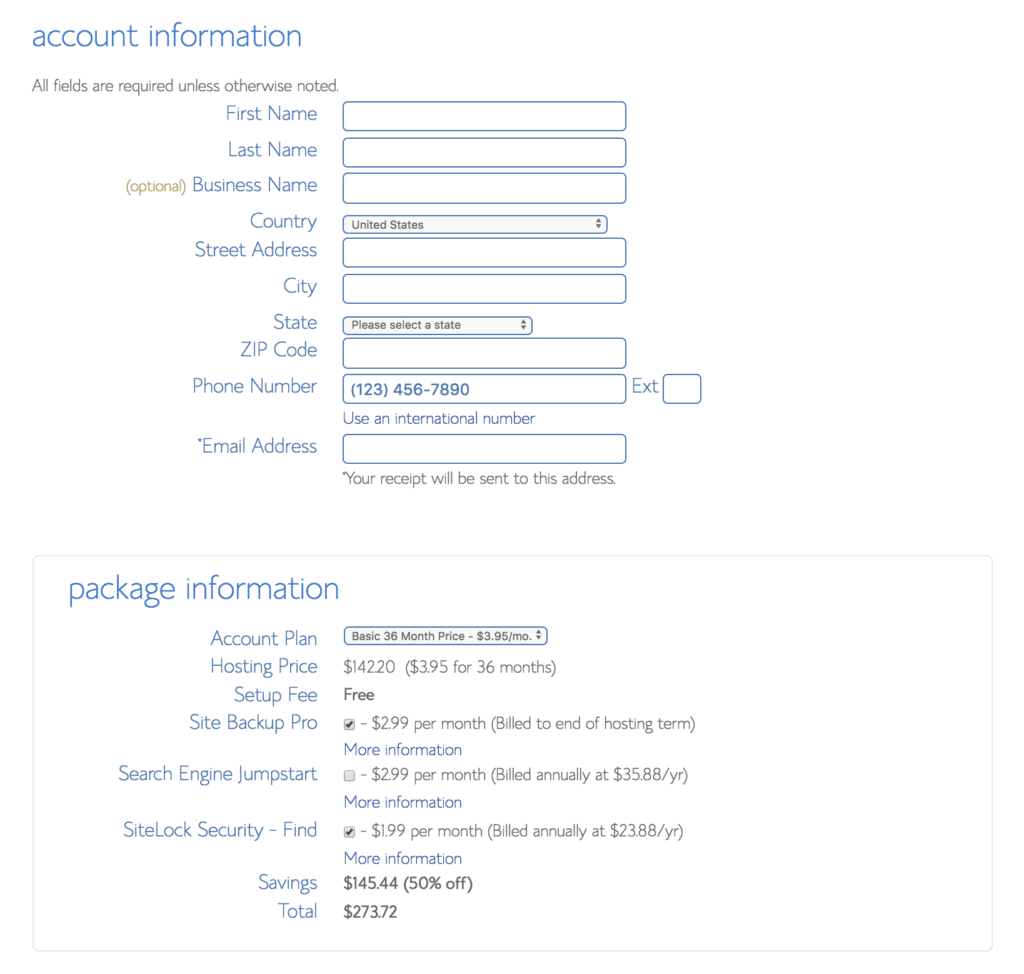
As you can see above, Bluehost gives you a few additional options when signing up. Feel free to add whichever you feel is important.
Once you’ve set up your account and domain name, you’ll be in business!
Then you’ll just need to build the furniture and decorate.
3. Install WordPress.org
Firstly, WordPress.com is a free, third-party website builder and host.
WordPress.org is the content management system (CMS) that you can install on your own hosted website.
We want WordPress.org. Why?
Because it’s awesome. So awesome, that WordPress makes up 29% of the world’s CMS.
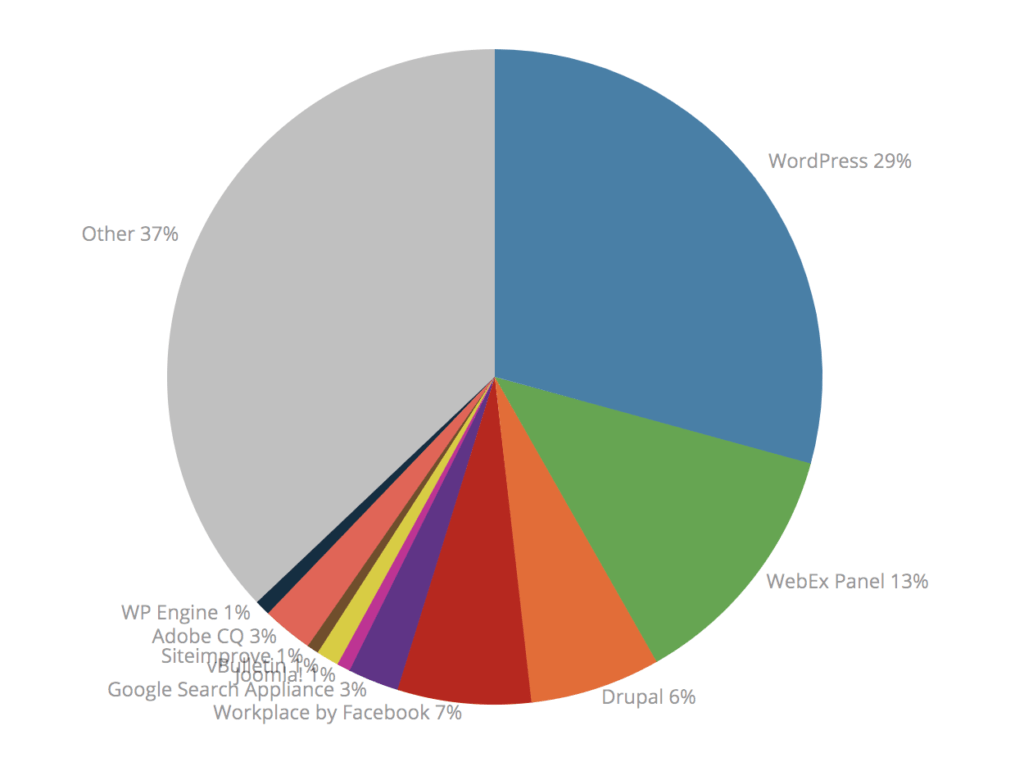
It’s so popular that users publish 17 posts every second on WordPress sites around the world.
Not to mention, all of these famous sites use WordPress, too:
- New York Post
- TED
- TechCrunch
- Fortune.com
- TIME.com
- New York Observer
- National Post
- Thought Catalog
- Spotify
Installing WordPress.org onto your Bluehost website is super easy with its famous “One-Click Install.”
Just log in to your new Bluehost account and click on the “cpanel”:
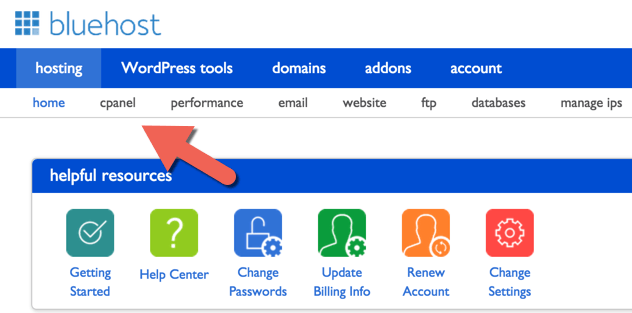
Next, click “Install WordPress” and follow the instructions.

Once you’ve installed WordPress, you’ll be able to go to yourdomain.com/admin and log in with the username and password you chose.
Now comes the fun bit.
4. Install a Sexy Theme
When you log into your new WordPress website, it’ll look something like this:
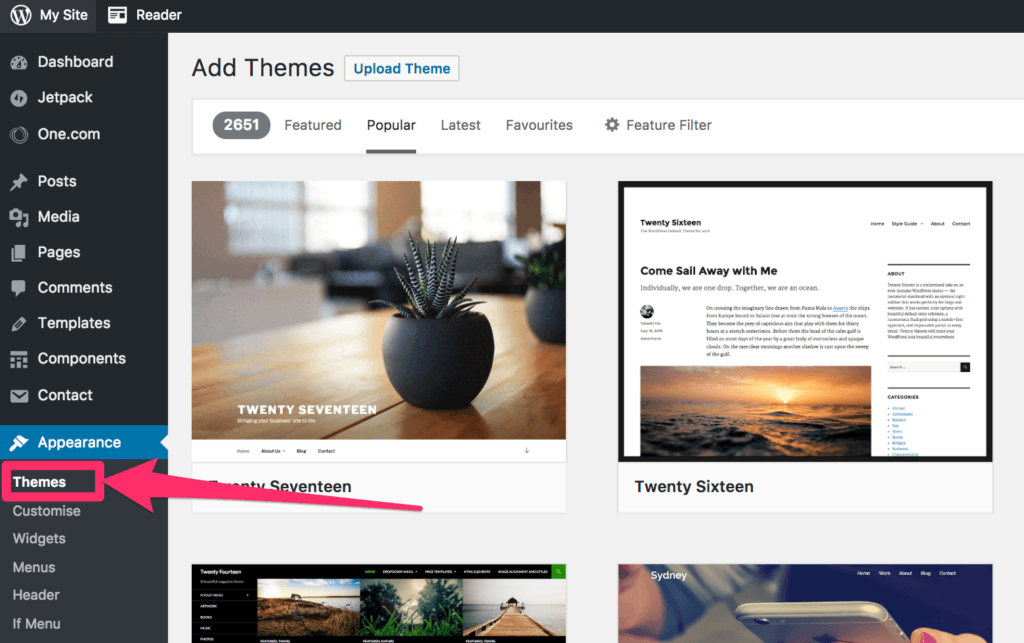
Click “Appearance,” then click “Themes,” and then click “Add New.”
You’ll now be able to browse and search for different themes.

Some themes are free and some you have to pay for.
Most themes have a free “lite” version with limited features and an option to upgrade to a “pro” version with more features.
Find a free theme that does the job, or consider purchasing a pro theme for extra features and support.
Whichever theme you choose, it must be “responsive.”
A responsive theme adapts to whatever device it’s being viewed on.
This is vital.
If you don’t have a responsive theme, your website will look bad and be difficult to use on mobile devices.
And according to Wolfgang Digital, mobile devices overtook desktop devices for browsing in 2016.
So before installing a theme, just make sure it says “responsive” somewhere in the description.

Ta-da! You’re good to go.
You might need to install a couple of different themes to find one you like.
Just take it slow, familiarize yourself with the WordPress interface and reference “how-to” videos on YouTube when you get stuck.
You’ve got this!
5. Install Some Plugins
A plugin is an add-on that gives your WordPress site extra functionality.
There are over 52,000 plugins in the official directory and there’s a plugin for everything.
Need social share buttons? Install a plugin. Need spam protection? Install a plugin. Need a margarita? Install a plugin.
Just click “Plugins” and then click “Add New,” and you’ll be able to browse.

Here are a few free essential plugins to get you started:
- Jetpack to gain website-tracking features and more
- Yoast for easy SEO
- Akismet to block spam
- Smush Image Compression and Optimization to make your pages load faster
It’s also a good idea to install a page builder plugin like Elementor Page Builder:
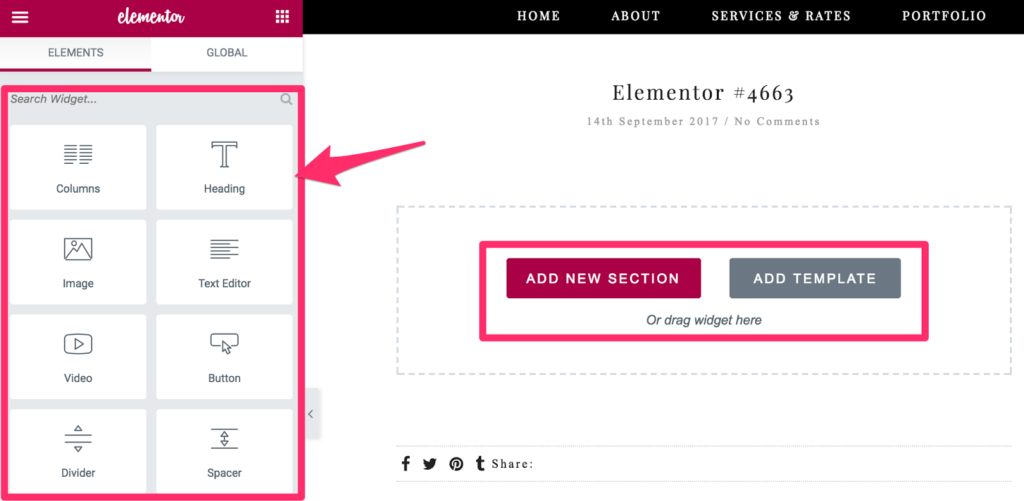
This plugin will let you build your website in a similar way to most free website builders.
Check out Neil Patel’s article, “9 Vital (And Free) WordPress Plugins Every Website Needs” to learn more about each of the plugins I’ve mentioned.
Once you’ve installed a plugin, it’ll show up in the left menu somewhere.
But here’s the catch: You won’t know where.
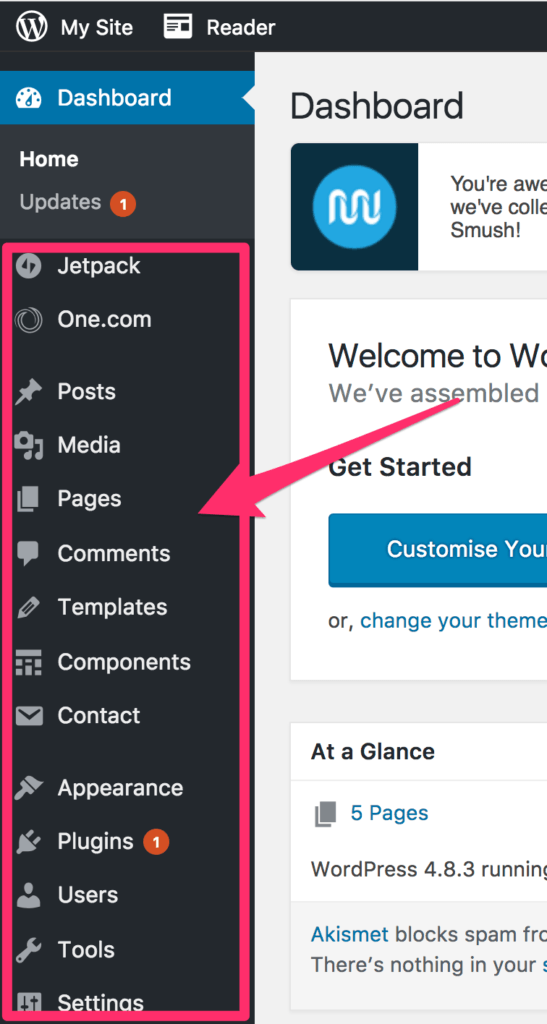
Different plugins show up under different menu headings and some even create their own menu heading.
So once you’ve installed a plugin, go hunting for it in that left-hand-side menu. Then you can adjust its settings.
Final Thoughts
There you have it!
Every professional freelancer needs a professional website.
By following these steps, you’ll lay the foundation for a quality website to market your services and snag new clients.
And more importantly, you’re one step closer to creating the life you’ve always wanted.
The next step?
And, if you need help packaging your skills, automating your client-getting process, and scaling your business, come watch the free How-To Case Study training at The No Pants Project.











